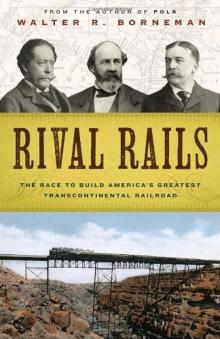Rival Rails: The Race to Build America's Greatest Transcontinental Railroad 

Genre: Other9
Published: 2010
View: 2313
Read OnlineRead Rival Rails: The Race to Build America's Greatest Transcontinental Railroad Storyline:
From Publishers WeeklyRailroads might seem outmoded today, but they were originally dynamic, cutthroat enterprises, according to this byzantine business history of track laying in the American West. Independent historian Borneman (Polk) chronicles the post–Civil War scramble to build a web of transcontinental railroads, lavish land grants, and government subsidies. Dozens of railroads and their executives are featured, but the melee eventually gels into a showdown between the Southern Pacific, intent on monopolizing the routes into California, and the Atchison, Topeka, and Santa Fe, determined to reach the Pacific by a prized snow-free southerly route. The regionÖs rugged topography forces railroads to compete for a handful of one-track-wide mountain passes and river crossings; rivals throw down miles of track per day to reach strategic junctions and occasionally send armed gangs to seize choke points. BornemanÖs evocations of railroad culture--the construction feats, boom-and-bust railhead towns, train robbers, and luxury cars--add color but are skimpy. He centers the story instead on boardroom maneuverings, and while railroad tycoons are a colorful lot, their deal-making begins to blur. As empire-building bequeaths corporate consolidation, BornemanÖs narrative runs out of steam before reaching the terminal. 16 pages of photos, 30 maps. Copyright © Reed Business Information, a division of Reed Elsevier Inc. All rights reserved. FromBefore the Civil War, the most logical route for the planned transcontinental railroad was across the southern plains and the deserts of the southwest. Instead, for reasons more political than economic, the more northerly route was selected, and the two strands were joined at Promontory Point, Utah, in 1868. Almost immediately, the competition began for the rights to build a web of lines across the southern route. Borneman, a historian and attorney, has written an interesting, if uneven, chronicle of the political as well as physical struggles to complete these tasks. He profiles numerous competing companies and their sponsors, and he describes their often cutthroat tactics and greed. Eventually, two large companies, the Southern Pacific and the Atchison, Topeka and Santa Fe, squeezed out or absorbed other competitors. When he sticks to the actual process of construction, Borneman’s narrative is brisk, colorful, and exciting. It drags and confuses when it deals with the machinations in corporate board rooms. Still, this is a worthy look at a less-publicized aspect of railroad construction. --Jay FreemanPages of Rival Rails: The Race to Build America's Greatest Transcontinental Railroad :